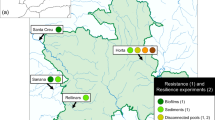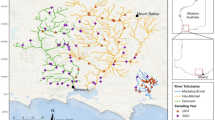Abstract
Wetlands play a very important role in ecosystems. Qixinghe Wetland is a nature reserve area in northeastern China. In this paper, diatom communities and environmental qualities were investigated at eight sites in Qixinghe Wetland. This study was to examine diatom species patterns in relation to environmental variables in wetlands, and to use diatoms as indicators to water quality in wetlands and wetland classification. Diatoms were sampled in summers and autumns in 2002 and 2004, during which 180 taxa were identified. Environmental variations in pH, temperature, biochemical oxygen demand (BOD), and chemical oxygen demand (COD) were measured. The seasonal composition and abundance of diatoms changed greatly during the study period. The relationship between diatoms and chemical water quality was estimated statistically. Canonical correspondence analysis (CCA) with forward selection and Monte Carlo permutation tests revealed that all water environmental variables changed during the study period (P <0.05). Among all the parameters, variation in BOD among the sites was a very important determinant of species composition according to the CCA, and BOD decreased from 2002 to 2004. Our results suggest that the water quality had improved during the three-year period because of enhanced environmental protection with less human disturbance. We conclude that diatoms can be used to indicate water quality and habitat conditions in this wetland.
Similar content being viewed by others
References
Adamus E R. 1996. Bioindicators for Assessing Ecological Integrity of Prairie Wetlands. U. S. Environmental Protection Agency, Western Ecology Division, Corvallis, OR, USA. EPAJ600/R-96/082.
Anderson N J, Rippey B, Stevenson A C. 1990. Change to a diatom assemblage in a eutrophic lake following point source nutrient redirection: a palaeolimnological approach. Freshwater Biol., 23: 205–217.
Bradshaw E G, Anderson N J, Jensen J P, Jeppesen E. 2002. Phosphorus dynamics in Danish lakes and the implications for diatom ecology and palaeoecology. Freshwater Biol., 47: 1 963–1 975.
Costanza R, d’Arge R, deGroot R et al. 1997. The value of the world’s ecosystem services and natural capital. Nature, 387: 253–260.
Cottingham K L, Carpenter S R. 1998. Population, community and ecosystem variates as ecological indicators: phytoplankton responses to whole-hike enrichment. Ecol. Appl., 8: 508–530.
Fan Y W. 2004. Research on Surirellales in Heilongjiang Province. Northeast Forestry University Press, China. 109p. (in Chinese with English abstract)
Gaiser E, Rühland K. 2010. Diatoms as indicators of environmental change in wetlands and peatlands. In: Smol J P eds. The Diatoms: Applications for the Environmental and Earth Sciences, 2nd Edition. Cambridge University Press, New York. p.473–496.
Hasle G R, Syvertsen E E. 1996. Marine diatoms. In: Identifying Marine Phytoplankton. Academic Press, California, USA. 858p.
Hieber M, Robinson C T, Rushforth S R, Uehlinger U. 2001. Algal communities associated with different alpine stream types. Arct. Antarct. Alp. Res., 33: 441–456.
Hornung J P, Rice C L. 2003. Odonata and wetland quality in Southern Alberta Canada: a preliminary study. Odonatologica, 32: 119–129.
King L, Clarke G, Bennion H, Kelly M, Yallop M. 2006. Recommendations for sampling littoral diatoms in lakes for ecological status assessments. J. Appl. Phycol., 18:15–25.
Kitner M, Poulíčková A. 2003. Littoral diatoms as indicators for eutrophication of shallow lakes. Hydrobiol., 506–509: 519–524.
Kovács C S, Buczkó K, Hajnal E, Padisák J. 2007. Epiphytic, littoral diatoms as bioindicators of shallow lake trophic status: Trophic Diatom Index for Lakes (TDIL) developed in Hungary. Hydrobiol., 589: 141–154.
Krammer K, Lange-Bertalot H. 1986. Bacillariophyceae. 1. Teil: Naviculaceae. In: Süßwasserflora von Mitteleuropa. Band 2/1. Spektrum Akademischer Verlag, Heidelberg. 876p.
Krammer K, Lange-Bertalot H. 1988. Bacillariophyceae. 2. Teil: Bacillariaceae, Epithemiaceae, Surirellaceae. In: Süßwasserflora von Mitteleuropa. Band 2/2. Spektrum Akademischer Verlag, Heidelberg. 611p.
Krammer K, Lange-Bertalot H. 1991a. Bacillariophyceae. 3. Teil: Centrales, Fragilariaceae, Eunotiaceae. In: Süßwasserflora von Mitteleuropa. Band 2/3. Spektrum Akademischer Verlag, Heidelberg. 599p.
Krammer K, Lange-Bertalot H. 1991b. Bacillariophyceae. 4. Teil: Achnanthaceae, Kritische Ergänzungen zu Achnanthes s. 1., Navicula s. str., Gomphonema. Gesamtliteraturverzeichnis. Teil 1–4. In: Süßwasserflora von Mitteleuropa. Band 2/4. Heidelberg: Spektrum Akademischer Verlag. 468p.
Laskar H S, Gupta S. 2009. Phytoplankton diversity and dynamics of Chatla floodplain lake, Barak Valley, Assam, North East India: A seasonal study. J. Environ. Biol., 30: 1 007–1 012.
Li J, Fan Y W, Wang Z B, Yang L P. 2007. Preliminary studies on diatoms from Qixinghe Wetland. Bull. Botan. Res., 27: 25–33. (in Chinese with English abstract)
Mayer P M, Galatowitsch S M. 1999. Diatom communities as ecological indicators of recovery in restored Prairie wetlands. Wetlands, 19(4): 765–774.
Noss R E. 1990. Indicators for monitoring biodiversity: a hierarchical approach. Conser. Biol., 4: 355–364.
Pan Y D, Stevenson R J. 1996. Gradient analysis of diatom assemblages in western Kentucky wetlands. J. Phycol., 32: 222–232.
Poulíčková A, Duchoslav M, Dokulil M. 2004. Littoral diatom assemblages as indicators of lake trophic status: a case study from perialpine lakes in Austria. Eur. J. Phycol., 39: 143–152.
Rautio M, Sorvari S, Korhola A. 2000. Diatom and crustacean zooplankton communities, their seasonal variability and representation in the sediments of subarctic Lake Saanajärvi. J. Limnol., 59: 81–96.
Rinella D J, Bogan D L. 2004. Toward a Diatom Biological Monitoring Index for Cook Inlet Basin, Alaska, Streams. Environment and Natural Resources Institute, University of Alaska Anchorage, Anchorage. 31p.
Schönfelder I, Gelbrecht J. 2002. Relationship between littoral diatoms and their chemical environment in northeastern German lakes and rivers. J. Phycol., 38: 66–82.
State Environmental Protection Administration of China. 2006. Standard Methods for Water and Wastewater Monitoring and Analysis, 4th Edition. Editorial Board ed. China Environmental Science Press. (in Chinese)
Weilhoefer C L, Pan Y D. 2007. Relationships between diatoms and environmental variables in wetlands in the Willamette valley, Oregon, U.S.A. Wetlands, 27(3): 668–682.
Whitmore T J. 1989. Flora diatom assemblages as indicators of trophic state and pH. Limnol. Oceanogr., 34: 882–895.
Yang X D, Dong X H, Gao G, Pan H X, Wu J L. 2005. Relationship between surface sediment diatoms and summer water quality in shallow lakes of the middle and lower reaches of the Yangtze River. J. Integr. Plant. Biol., 47: 153–164.
Yang X D, Kamenik C, Schmidt R. 2003. Diatom-based conductivity and water-level inference models from eastern Tibetan (Qinghai-Xizang) Plateau lakes. J. Paleolimnol., 30: 1–19.
Author information
Authors and Affiliations
Corresponding author
Additional information
Supported by the National Natural Science Foundation of China (Nos. 30870157, 31070183), the Natural Science Foundation of Heilongjiang Province, China (No. C200828), the Aid Program for Science and Technology Innovative Research Team (No. KJTD2011-2), and the Projects in advance of Harbin Normal University
Rights and permissions
About this article
Cite this article
Fan, Y., Li, J., Men, X. et al. Preliminary description of diatom community and its relationship with water physicochemical variables in Qixinghe Wetland. Chin. J. Ocean. Limnol. 30, 379–387 (2012). https://doi.org/10.1007/s00343-012-1108-9
Received:
Accepted:
Published:
Issue Date:
DOI: https://doi.org/10.1007/s00343-012-1108-9




